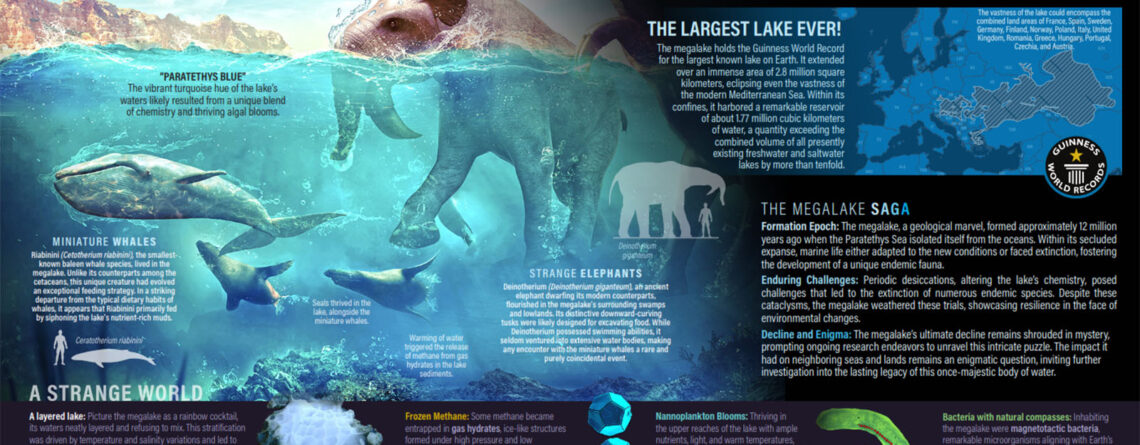The discoveries of a team of Romanian researchers have won a place in the Book of Records. It is about a team led by Dr. Dan Palcu, made up of researchers from the GeoEcoMar Institute and researchers from the University of Bucharest, a first for the two institutions. The team discovered the immense proportions of the largest lake in the history of planet Earth: the Paratethys. Guinness World Records has published an article online dedicated to “The Largest Lake That Ever Existed” and the record has also been published in print editions in over 40 languages.
About 11 million years ago, in a geological epoch called the Upper Miocene, the European continent looked very different than it does today. The most impressive feature of the continent was probably the Paratethys – a body of water that stretched from the east of the Alps mountains to the regions that today belong to Kazakhstan. Dan Palcu and his colleagues determined the proportions of the mega-lake in a study published in June 2021.
At its height, the Paratethys covered an area of about 2.8 million square kilometers and contained over 1.8 million cubic kilometers of brackish water (fresh water combined with salt water in varying proportions). That’s more than ten times the combined volume of all current freshwater and saltwater lakes.
For a long time, it was believed that there was a prehistoric sea here, the Sarmatian Sea. Now we have clear evidence that for about five million years, this sea became a lake – isolated from the ocean and full of animals never seen anywhere else on the globe. The lake covered a large part of Romania’s territory, apart from the mountainous areas, and left behind spectacular testimonies, such as the sands with trovants in the Subcarpathians of Buzăului and Oltenia under the mountain, the limestones in the Istrita area that 10 million years ago were tropical beaches , and the reddish cliffs of Southern Dobrogea, where the filling and drying cycles of the lake are reflected in the whitish-reddish alternations of the rocks.
The mega-lake Paratethys was characterized by a unique local fauna. Dan Palcu and his colleagues revealed the tumultuous history of the Paratethys, marked by multiple hydrological crises and drying periods. During the most severe crisis, the mega-lake lost more than two-thirds of its surface area and one-third of its volume, with the water level dropping by as much as 250 meters. This had a devastating impact on the fauna and many species became extinct, including Cetotherium riabinini – the smallest whale found. To unravel the history of the megalake, the researchers used a technique called magnetostratigraphy – using the recording of polarity reversals of the Earth’s magnetic field in rocks as a dating tool. To determine the size and volume of the Paratethys megalake, the researchers used digital paleogeographic reconstructions. Their contributions were thus essential to this fascinating story led by Dr. Dan Palcu.
Our investigations go beyond simple curiosity. They reveal an ecosystem that has responded dramatically to climate fluctuations. By exploring the cataclysms this ancient mega-lake endured as a result of climate change, we gain invaluable information. With their help, potential ecological crises triggered by climate change that our planet is currently experiencing can be elucidated. At the same time, our research sheds light on the stability of toxic water basins, such as the Black Sea.
He explains that the modern Black Sea mirrors many environmental features of the ancient Paratethys. Largely devoid of life-sustaining oxygen, the deep Black Sea harbors waters rich in hydrogen sulfide—a toxic gas harmful to both humans and most animal species. Moreover, Black Sea sediments contain “frozen” methane, an exceptionally potent greenhouse gas that could be released into the atmosphere in response to global warming, thus triggering environmental catastrophes. Dr. Palcu is currently researching the resilience of these ecologically fragile regions to climate change and human-induced modifications, through a project funded by PNRR. Thus, he emphasizes that deciphering the history of the Paratethys is not only a journey into a tragic past, but also a beacon of hope for the future:
The modern Black Sea has the potential to become one of the largest natural carbon storage regions. Its stability is of paramount importance for future carbon storage initiatives and the prevention of future ecological disasters.
Earning a place in the Book of Records is a huge achievement and will inform many about the fascinating science surrounding this mega-lake. Since its inception in 1954, Guinness World Records has sold more than 150 million books in more than 100 countries and has been translated into more than 40 languages.
The study was a collaboration between the University of Utrecht (Netherlands), the University of São Paulo (Brazil), the Russian Academy of Sciences (Russia), the Senckenberg Biodiversity and Climate Research Center (Germany), INCD GeoEcoMar and the University of Bucharest (Romania) , led by Dr. Dan Palcu.


